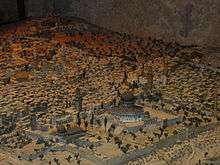Illés Relief

Illés Relief is a 1:500 scale model of the holy city of Jerusalem. The model is made from molten and beaten zinc and is hand-painted. It was hand-crafted between 1864 and 1873 by Stephen Illés (Hungarian: [ˈilːeːʃ]), a Hungarian Catholic who lived in the city making a living from book binding. The scale model reflects the city under the later stages of Ottoman rule. The model is considered the first scientific relief model of the city.[1]
After being displayed at the 1873 World's Fair, the model was displayed around Europe and was purchased in 1878 by community leaders in Geneva where it was displayed for 40 years.[2] In 1920 the building in which the model was housed was leased by the League of Nations. The model was moved and soon forgotten.[3] In 1985, then graduate student Moti Yair of the Hebrew University came across a reference to it and tried to track down its location. With the help of some friends and a librarian from the Library of Geneva, the model was located in the library attic.[3] Shortly afterwards it was decided to offer the model to Jerusalem on permanent loan.[3] It is currently on exhibition at the Tower of David Museum in Jerusalem.[2]
References
- ↑ "Liberate the Illés Relief - Opinion". Al Jazeera English. Retrieved 2012-08-13.
- 1 2 "Tower of David Museum of the History of Jerusalem | Model of Jerusalem in the 19th Century". Towerofdavid.org.il. Retrieved 2012-08-13.
- 1 2 3 Eylon, Lili. "Four Periods in the History of Jerusalem". Jewish Virtual Library.
| Wikimedia Commons has media related to 19th-century model of Jerusalem. |